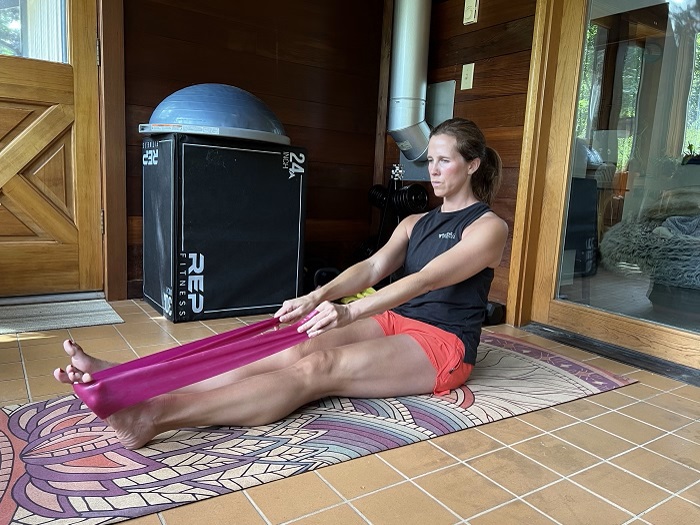Ankle injuries are common in runners, but the good news is they’re often preventable. Beyond avoiding doing too much too soon, you can easily add in a few ankle strengthening exercises to your weekly routine.
As a runner, there’s always some worry in the back of your mind (or maybe in the front of your mind) that you could get injured. And just like that, there goes your next race or maybe just your next workout.
Which is why you hear me so often talking about pre-hab.
That’s adding small movements to your dynamic warm up which work muscles that prevent injuries (often the hips and glutes). I recommend doing them often in the warm up because it ensures that we don’t skip them and helps to activate our muscles.
However, if you are currently rehabbing from an ankle injury these might be movements you do a few times a day before you resume running.
Start by ensuring you know the cause of your ankle pain while running. You need to know which muscles to focus on and ensure that it’s not something more serious like a stress fracture before continuing.
Learning some different ankle strengthening exercises can be the difference between meeting your goals in that next race and sitting on the sidelines. So without further ado, let’s talk more about ankle strength and some specific exercises you can implement right now.
Why Does Ankle Strength Matter for Runners?
We know that running works a lot of muscles and it makes sense that we need strong glutes for more power in our stride, but what does ankle strength really do for you?
I think you’re going to be surprised at some of the answers! Like it could make you faster!
Strong Ankles Prevent Common Running Injuries
Nobody wants to run in pain so we’re always looking for ways to avoid injuries.
The American Journal of Sports Medicine conducted a study with cadets in military training that determined one way to help fend off running injuries is to strengthen ankle dorsiflexion and plantar flexion (the movement of the top of your foot towards your shin and away from your leg respectively).
This helped avoid Achilles tendon overuse injury.
We’re also prone to ankle plain, shin splints, running knee pain and Plantar Fasciitis if our ankles don’t have enough strength to keep the foot stable throughout the run.

Ankle Stability Reduces Knee and Foot Pain
Keeping your ankles in good shape will decrease your chances of ankle sprains and strains where the ligaments are torn. But it will also significantly reduce your chances of experiencing other running pains.
When your ankles are strong, the mobility in the ankle joints is good. This mobility is what allows you to run with proper form. It allows your body to remain in alignment, without the foot rolling inward or outward.
Good running form means you prevent foot pain while running and could event help prevent osteoarthritis by ensuring joints remain in proper alignment and don’t rub cartiledge.
Improves Performance and Stamina
A study by Medicine & Science in Sports & Exercise looked at the performance of recreational and competitive distance runners during a hard treadmill workout.
It concluded that long-distance runners could benefit from doing exercises to work their ankle plantar flexor muscle-tendons. The ankle plantar flexor stores a lot of energy, which made its strength very important to overall running performance and avoiding fatigue.
Strong Ankles Allow You to Run Faster
A strong ankle has a measure of stiffness during the run that allows your foot to act like a spring.
When you take a step it absorbs the impact without collapsing, but instead springing back up and forward with power! If your ankles are weak then they will not have that stiffness to push back quickly.
Additionally, by being able to pull the ankle up during the foot strike you end up with a shorter ground contact time.
How Can I Strengthen My Ankles?
Weak ankles can absolutely be strengthened!
Although you can be more prone to weak ankles because of genetics, running form, running shoes, or previous trauma, you’re not stuck with weakness in your ankles forever.
Even if you have chronic ankle instability, there are ways to strengthen your ankles.
There are a few basic things you can do to strengthen your ankles, which as a runner you possibly already do:
- Always complete a dynamic warm up before you run.
- Wear shoes with proper ankle support so your ankles aren’t overworked.
- Strengthen your hips, glutes and core to help your body remain in good alignment with each step.
- Foam roll or use a massage gun on the shins, calves and feet to release tight muscles.
- Go to physical therapy to identify any specific weaknesses that might be leading to your ankle pain.
- Do exercises that specifically work to strengthen your ankles.
Ankle supports for running can also provide stability to the joint and help to prevent excessive movement that can lead to sprains or other injuries. They’re going to do more than running shoes for ankle support because it will come up higher, but using them together might be the best long term option to ween off the brace.
Assessing Your Ankle Strength and Flexibility
Before beginning any new exercise routine, it’s important to assess your starting point. With ankle exercises, this means evaluating your ankle strength and flexibility.
By understanding where you stand, you’ll be able to identify any weaknesses that need strengthening and track your progress over time.
Signs of Weak or Inflexible Ankles
If you’re not sure if you have weak or inflexible ankles, there are a few signs to look out for. Pain or discomfort in your ankles, feet, or lower legs are common signs of ankle weakness. This pain can be caused by overuse, injury, or simply weak muscles around the ankle joint.
Plus, if you notice that your ankles are wobbly or unstable when you stand, you may need to work on your ankle strength.
Ankle instability can be caused by a variety of factors, including weak muscles, ligament damage, or poor proprioception (your body’s ability to sense its position in space).
Simple Tests to Evaluate Your Ankle Strength
One simple way to assess your ankle strength is to perform a single-leg balance test. Stand on one foot and see how long you can maintain your balance. Repeat on the other foot.
If you struggle to maintain your balance for more than a few seconds, this indicates that your ankle strength may need improvement.
Another test you can try is the heel raise test. Stand with your feet shoulder-width apart and lift your heels off the ground, rising up onto the balls of your feet. Hold this position for a few seconds, then lower your heels back down to the ground.
Repeat this exercise for a few repetitions. If you struggle to maintain your balance or feel pain in your ankles during this exercise, you may need to work on your ankle strength.
Identify Areas for Improvement
After assessing your ankle strength and flexibility, identify areas where you need to improve. If you struggle with balance, for example, you’ll want to focus on exercises that target your ankle stability.
This could include single-leg balance exercises, such as standing on one foot with your eyes closed, or exercises that challenge your balance, such as standing on an unstable surface like a balance board or foam pad.
If you experience pain in your ankles, you may need to work on your flexibility through stretching exercises. Tight muscles around the ankle joint can contribute to pain and discomfort, so incorporating stretches like calf stretches, ankle circles, and toe raises into your routine can help improve your ankle flexibility.
Remember, it’s important to start slowly and gradually increase the intensity and duration of your ankle exercises. Overdoing it can lead to injury or further weaken your ankles.
By taking the time to assess your ankle strength and flexibility and focus on areas for improvement, you’ll be on your way to stronger, healthier ankles in no time!
10 Ankle Strengthening Exercises
When and how often you perform these moves will depend on your needs. Some runners love doing them at least 3 times per week, others might toss it in the routine once a week because they don’t have a ton of ankle issues, but want the benefits.
#1 Plantar Flexion Stretch
Plantar flexion involves pointing your feet away from your body. Clear examples of using this movement are pressing the gas pedal of your car and standing on tiptoes.
This stretch will help with the flexibility and strength of your ankles.
- Sit down on the floor with your legs straight out in front of you.
- Point one foot away from you, and hold it.
- After 10-15 seconds, stop.
- Try the same thing with the other foot.
You can also try this stretch with a resistance band to get more out of the stretch. Put the band around the bottom of your foot in the middle, and hold both ends. Then point your foot away from you, pulling on the band to increase resistance.
Using the band pre-run is a great warm up.

2. Dorsiflexion Stretch
Dorsiflexion is essentially the opposite of plantar flexion. It means you bring your toes up towards your shin. Think about the motions in your feet as you’re going up a flight of stairs, walking, or running.
Dorsiflexion also aids in ankle strengthening and flexibility.
- Sit down on the floor with your legs straight out in front of you.
- Bend one foot up towards your shin, and hold it.
- Stop after 10-15 seconds.
- Repeat with the other foot.
This is another stretch you can do with a resistance band to maximize strengthening. Put the band around the top of your foot in the middle, and attach the ends of the band to something heavy. Then bend one foot up towards your shin, and hold it.

3. Calf Raises/Standing Heel Raise
Calf raises or standing heel raises are similar to the plantar flexion stretch, except now you’re adding your body weight to the mix. You’re also working your calf muscles!
- Stand up straight with your feet hip-length apart.
- Slowly lift your heels off the ground like you’re reaching for something up high.
- Slowly lower your heels back down to the ground. The key is to be controlled in your movements.
Bonus – place a ball between your heels to really ensure you are fully engaging the ankles.

4. Ankle Alphabet
Ankle rotations are used to improve the ankle’s range of motion and stretch the muscles around the ankle. Basic movement is just side to side, but you might as well take it up a notch by doing a little more.
- Lie down with your back on the floor and lift one leg about 20 inches off the floor.
- Use your foot to draw out the letters of the alphabet (so much harder than it sounds!)
- Follow the same process for your other foot.
5. Single Leg Balance
This is a great exercise to not only increase your ankle stability, but your knee and hip stability as well. It also helps to improve your balance, which is key since running is a single leg sport that requires core activation.
- Stand up straight with your feet hip-length apart.
- Shift all of your weight onto one of your feet, and lift the other off the ground with knee at 90 degrees.
- Slowly move the lifted foot around in circles. Or you can draw the alphabet instead.
- Bring your foot back down.
- Repeat with the other foot.
Progress this by going barefoot, then standing on a pillow or a wobble board! The unstable surface is going to activate more muscles and require you to really use your core.

6. Towel Grab
This is an effective exercise to strengthen the muscles around your feet and ankles. Remember that strong feet improve ankle stability as well. You can do this exercise either in either a sitting or standing position.
- Put a small towel under your feet.
- Curl your toes from your right foot around the towel to grip it.
- Lift the towel off the ground.
- Hold it for a few seconds, then release.
- Repeat the process for the left foot.
7. Duck Walk Exercise
The next three exercises are demonstrated in this video because I think that helps provide more context!
In the duck walk, you are staying in a very low squat as you walk forward. This is going to force your ankles to work through a wide range of motion and require a lot of strength and stability.
You’re getting the added bonus of strengthening your hips and glutes for even more injury prevention!
Try walking forward 10 steps at first and increase to 30 seconds.
8. Bear Ankle Press
This is going to activate your ankles, shins and core. It’s also a more advanced way to work on plantar flexion.
- From a table top position, you will keep your feet flat on the floor and press in to the top of your feet.
- Hold for a couple of seconds and then return to neutral.
- Repeat 5-10 times.
9. Ankle Mobility
One overlooked piece of strength is having enough mobility to move through a full range of motion. That’s why many of the movements above are also called stretches.
You’ll notice in the video that we are keeping the foot planted on the floor while moving the knee through small movements. Over time you should feel like you can move in greater degrees to each direction.
10. Heel Toe Walks
Heel to toe walks are an ideal way to work the muscles that often lead to shin splints.
- Barefoot rock back on to the heels with legs straight and walk forward 10 steps
- Raise up on to the toes and walk 10 steps back to where you started
- Additionally you can practice doing both moving side to side

Tips for Incorporating Ankle Exercises into Your Running Routine
Running is a fantastic way to stay fit and healthy, but it can also put a lot of strain on your ankles. Incorporating ankle exercises into your running routine can help strengthen your ankles, improve your balance, and prevent injuries. Here are some tips to help you get started:
Create a Balanced Workout Plan
When it comes to incorporating ankle exercises into your running routine, it’s important to create a balanced workout plan.
This means incorporating ankle strengthening exercises into your overall workout routine, balancing the exercises with other running-specific workouts like hill sprints and tempo runs.
By creating a balanced workout plan, you can improve your overall fitness and reduce your risk of injury.
Gradually Increase Intensity and Duration
It’s important to start with low-intensity ankle exercises and gradually increase the intensity and duration as your strength improves.
Aim for 2-3 sets of 10-15 reps for each ankle exercise. This will help you build strength in your ankles without overdoing it.
Over time, you can increase the intensity and duration of your ankle exercises to continue challenging your ankles and building strength.
Listening to Your Body and Avoid Overtraining
As with any exercise program, it’s important to listen to your body and avoid overtraining. If you experience pain or discomfort, take a break and allow your ankles to rest and recover.
Overtraining can lead to injuries and setbacks, so it’s important to take a balanced approach to your ankle exercises and listen to your body’s signals.
Incorporating ankle exercises into your running routine can help improve your overall fitness, reduce your risk of injury, and keep you running strong for years to come.
So why not give it a try? These ankle strengthening exercises are simple enough to do, and the payout is worth it!
When runners strengthen their ankles there are so many benefits. You can run faster, improve your stamina, and run pain and injury-free.
Even if you have weak ankles you can begin to strengthen your ankles with proper running form, good shoes, and of course, effective exercises.
Looking for additional guidance?
- Video: Foot strengthening Exercises from a Physical Therapist
- Improving Your Foot Strike
- Best Running Shoes for Ankle Pain
Other ways to connect with Amanda
Instagram Daily Fun: RunToTheFinish
Facebook Community Chatter: RunToTheFinish
Sign Up to Receive a Weekly Newsletter with Top Running Tips and Laughs




 A Complete Beginner’s Guide to Progressive Overload Training
A Complete Beginner’s Guide to Progressive Overload Training